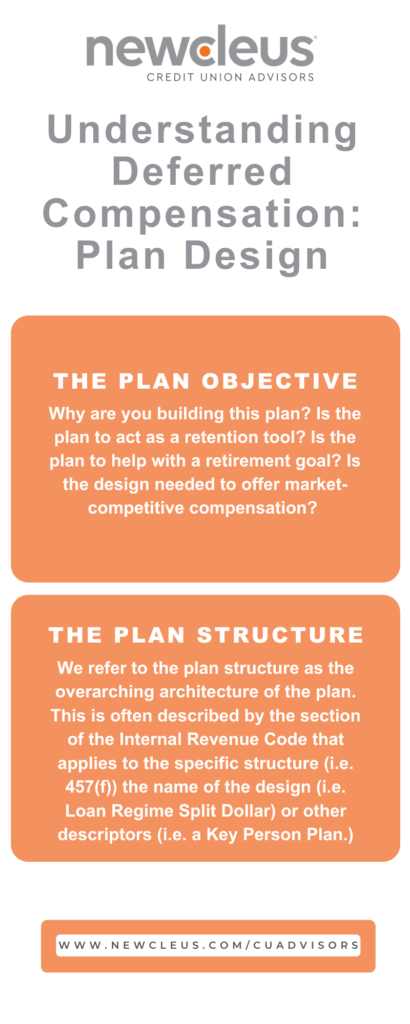


Deferred compensation plans can be a valuable tool for your credit union. In the current market, we’re seeing a lot of executive turnovers as well as tremendous competition for talented individuals across the marketplace. Deferred compensation plans can be a sound place to deploy some of the excess liquidity on your balance sheet while helping reinforce executive retention.
Historically, deferred compensation plans have been used as a means to retain the CEO, but more recently, we are seeing rapid adoption of these plans in order to retain entire executive teams ensuring consistent leadership of the credit union for years to come.
In order to understand how you can structure your deferred compensation plans, you must first understand what these plans entail.

Non-qualified deferred compensation (NQDC) plans come in many flavors. NQDC plans are not subject to certain protections under the Employee Retirement Income Security Act of 1974 (ERISA). As such, they are typically only allowed to be offered to employees who are highly compensated or from a select group of management employees.
These plans are structured through specific written agreements between the credit union and employee. The plan design can include self-deferral of the executive’s compensation, grants of compensation by the credit union, a specified benefit payable at some point in the future, or a more complex structure involving life insurance and specialized loans. The tax implications, flexibility, drawbacks, and benefits under each plan type will vary widely. Most boards and CU management teams don’t have the deep expertise needed to work through the benefit/drawback analysis of the varied plan types themselves.
Another aspect of non-qualified plans is the risk to the employee of default of the sponsoring organization. While the default is not normally the path for resolution of challenged credit unions, the risk of “what if” in any circumstance should be considered as you evaluate the plan alternatives.
Currently, in credit unions, Loan Regime Split-dollar and 457(f) are the two major non-qualified deferred compensation plans in use. These plans are very different in how they operate and can offer different ways for the executive to receive their benefit. The important aspect of implementing any deferred compensation plans is ensuring the design you choose to implement matches the objective you’re trying to accomplish and you’ve carefully considered the benefits and drawbacks of the chosen plan design in the language a board or management team can understand.
Deferred Compensation Plan Design: The Plan Objective
When considering deferred compensation for your key executives the first item you should address is the plan objective. Why are you building this plan? Is the plan to act as a retention tool? Is the plan to help with a retirement goal? Is the design needed to offer market-competitive compensation? These are just a few of the elements you should identify when constructing the plan for your credit union. Once the objective is defined, you should begin consideration of other elements including the plan design, plan funding, and ongoing plan administration.
Deferred Compensation Plan Design: The Plan Structure
We refer to the plan structure as the overarching architecture of the plan. This is often described by the section of the Internal Revenue Code that applies to the specific structure (i.e. 457(f)) the name of the design (i.e. Loan Regime Split Dollar) or other descriptors (i.e. a Key Person Plan.)
A given plan may include more than one structure to achieve the overall plan objective in the best way possible. Understanding the risks and benefits of various plan designs normally leads to a more prudent outcome for the CU and the executive. The key to achieving the most effective design is working with a provider who can address varied plan types as well clearly and effectively communicate the benefits and drawbacks of those same designs.
Vesting and other plan attributes can be highly customized depending on the needs of your credit union. The key is to use the defined objective to ensure alignment between the plan and the board’s desired outcome. For instance, If you want your CEO to remain at the CU for 15 years, you would likely include that attribute in the plan design. Conversely, you may want a senior executive to remain with the CU—but you acknowledge they may need to seek their best opportunity elsewhere. In this instance, you could use the NQDC plan to encourage the employee to stay for a specific duration of time. In short, the objectives of the credit union and the life stage/circumstances of the employee should both be incorporated in an optimal plan design.
Additionally, the competitive market for compensation of all types (including Non-Qualified Deferred Compensation) may drive the value you attribute to the plan. It often helps boards to understand the current norms of the marketplace to ensure they’re not missing out on a talented candidate, or worse, losing a valuable team member because they aren’t offering a competitive compensation and benefits package.
Finally, it is expected that key executives will perform at a high level. Boards may wish to include performance-based components in the overall plan design. This is to ensure high performance is rewarded, but that a substantial benefit must be earned by the participating executive. This final component should involve a dovetailing of the NQDC plan with your overall compensation plan and philosophy. Selecting a provider that can bring depth in both areas can be very helpful to a prudent and sound plan design.
Deferred Compensation Plan Design: The Plan Investment
While many providers lead with reference to a specific plan or product, we’ve found this leaves many plan needs unaddressed. In our mind, the best approach is to begin with the needs of the organization, the attributes needed within the plan, then a comparison of various plan alternatives. It is key to remember “there is no such thing as a free lunch.” This carries through to NQDC plan design as well. You want to ensure your provider is able to work with all products currently available in the market while being able to present both the positives and drawbacks of any given approach. No plan investment or design is a panacea—all of them have drawbacks as well as benefits. The key, however, is ensuring the board and executive are able to weigh those attributes in a forthright fashion.
Deferred Compensation Plan Design: Administration
Often an afterthought, plan administration is a vital aspect of any plan structure. For some NQDC plans, servicing may be required for 30 or more years. You need to ensure your provider has the depth, resilience, and succession plan to ensure the ability to serve the plan is not in question. You should also ensure your provider creates a roadmap to help facilitate a transparent overview of the plan. Finally, the administration platform needs to work effectively with the needs of the credit union. Specifically, the people at the credit union who will be responsible for reporting and recordkeeping with respect to the plan. We’ve found the administration component is an often overlooked aspect of plan evaluation and one that causes substantial headaches down the road.
At Newcleus CU Advisors, we place a heavy emphasis on the proper approach to your deferred compensation plan design. We want to help create a plan that serves the needs of your credit union as well as providing value to your executives. Our goal is to create a lasting partnership earned through superior competence and retained through superior service.
